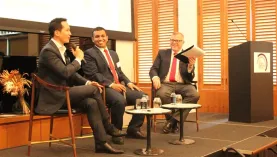Exclusive
How AI will dominate banking in Asia
How AI will dominate banking in Asia
Hillstone Networks, Latize, and Software AG Asia share why AI is the future of banking. Startup fintechs, e-commerce brands, and even established giants such as Google, Apple, Amazon, and Facebook are scrambling for their place in the money market, all driven by today’s rapidly evolving technology. This disruptive, game-breaking factor spoils consumers with convenience and intuitiveness in all facets of their life, and banks that fail to deliver just that will see their clients walking out the door. Fortunately, these alternative channels have not encroached that deeply into the traditional banking sector—yet. This gives banks a chance to step up their game, be more competitive, and hold their ground. Alan McIntyre, senior managing director and head of banking practice at Accenture, in their Banking Technology Vision 2017 report, explains, “The more goals a bank helps people achieve, the more confident people will be in the partnership, yielding an ever-stronger relationship with each interaction.” Reflecting the same sentiment is Anneliese Schulz, vice president of Software AG Asia. She says, “With the digital revolution changing the rules of banking, exceeding customer expectations is the key to growth and remaining competitive.” One way to achieve this is through trends such as artificial intelligence. Schulz explains this, saying, “Banks have to adopt a cohesive digital strategy by leveraging disruptive technologies such as AI to reimagine the customer experience and offer customers choices of where, when, and how they bank.” The AI experience “Elements of AI have been used in banking, finance, and insurance firms for quite some time now,” says Tim Liu, CTO of Hillstone Networks. “Backed by machine learning and big data, AI can automate tasks previously done by humans to help us make better, more informed decisions.” These machine learning systems will drive AI applications towards the ease of interaction customers are craving for. Better yet, the longer they run and the more they gain experience from data, the more effective they will be in addressing various banking situations, streamlining processes, and supporting customers. As it stands though, banks have only played on the fringes of AI’s full potential. Vikram Mengi, co-founder and CEO of Latize, says that it’s a huge missed opportunity. The data is there already, but “the problem with this is that the data is not necessarily in a form that can be easily utilised. However, by infusing the data with intelligence, one can transform all that data into a form that is easily usable.” Mengi sees the true success of AI in banking when these three aspects have been realised: a single knowledge base unifying all relevant diverse data sets; utilising knowledge representation models to interrogate known facts and infer unknown truths; and using abstraction layers through continuous application and learning from diverse data sets. “Banks have access to vast amounts of data and practical alignment of the above mentioned three aspects will result in value generation for banks and conversely the customers they’re serving,” he adds. In fact, 79% of banks surveyed in the Accenture report agree that AI will drastically improve their whole business and client relationships. Twenty-nine percent agree that it is critical for their products and services to be offered using centralised platforms, virtual assistants, and chatbots. Moreover, 76% foresee that most banks will have AI interfaces as their main customer touch points in the next three years, whilst a surprising 71% of them agree that AI can be the face of their business. To further emphasise how fast technology is evolving, it’s important to note that this AI-first mindset is quickly overtaking the relatively young mobile-first movement. Fitting into the puzzle “Moving forward, there are a number of areas in the industry where the implementation of AI can help streamline and improve processes,” says Liu. He notes areas like customer-facing functions and targeted marketing as two areas where AI can make an immediate, noticeable impact. Customer-facing functions involve the aforementioned robo-advisers, virtual assistants, and chatbots. In using AI applications for these services, “customer service can take a giant leap forward by eliminating the frustrating waiting time we are accustomed to,” says Liu. “Poor performance in this area is also a reason many internet banks have difficulty scaling up. Banks have adopted automated response systems for customer service and the system has improved over the years.” Besides being efficient time-wise, AI also frees customer service agents to focus more on complex situations where machines can’t match human empathy and intuition. Besides providing advice without human intervention, Schulz comments that the endeavor results in cost savings. “The key advantage of robo-advisers is that customers receive investment advice based on algorithm-based formula at a fraction of the cost of traditional financial advisors.” She adds, “Banks will see more automation and consolidation in asset management through the adoption of robo-advisors to improve customer experience. Eight in 10 consumers in Singapore would welcome robo-advisory services for their banking, insurance, and retirement planning according to a study by Accenture.” Banks can also implement AI to better bring customers the products and services that fit their needs. Liu says that after all, BFSIs do have the transactional and personal data necessary to determine the spending patterns and financial health of their clients. “Based on personal and demographic data, the system can identify opportunities and patterns previously unidentifiable by the human eye. This helps to better profile and therefore personalise marketing efforts to consumers, enabling prompt decision-making on marketing efforts to maximise impact and returns.” Schulz also points out that investments banks are researching how predictive analytics and machine learning can improve profitability through providing assisted decision-making in the sales and trading departments. “Banks are learning how to effectively use predictive analytics and machine learning to monetise customer data to create new capital from data sources and ultimately transform their business models,” she explains. In addition, Mengi says that AI can better secure the banking environment through anti-money laundering and anti-fraud measures. Going back to the amount of data banks have, they can “sift through it to spot irregularities and patterns that point to money laundering activity instead of just looking for anomaly and irregular pattern detection based on statistical methods.”
Malaysian banks weather decreasing customer loyalty as fintech booms
Non-banks are enjoying increased customer attention and retention. Transaction values rose a staggering 21% in Malaysia’s startup ecosystem over the past year, indicating relentless support for further innovation and acceleration of the fintech market. As money pours into the fintech space in the country, Malaysian banks are increasingly being threatened to widen their ecosystems and cross-sell more products as fast as the likes of Ping An. With the rise in diversified and exciting products from fintech startups, clients are slowly easing out their traditionally preferred banks in favour of these non-traditional providers. The number and extent of transactions with a non-bank have simultaneously increased with the volume of digital disruptions happening within a country, and Malaysia is no exception to the increasing numbers of fintech clients especially in Kuala Lumpur. Banks have begun looking at increasing digital transformation needs in capital allocation planning for the next two to three years, according to Liew Nam Soon, managing partner for financial services in ASEAN, Ernst and Young, and 85% of those that EY surveyed have established a digital transformation function with executive positions such as chief of fintech, chief of data, and chief of innovation. During the Kuala Lumpur leg of the Asian Banking and Finance Retail Banking Forum 2017, Nam Soon emphasised that banks need bold strategies to compete in today’s new normal environment, where the digital ecosystem continues to emerge and where financial institutions maximise innovations around robotic process automation, robo-advisory, artificial intelligence, chat bots, application program interface (API), and blockchain, among others. Loyalty blues As traditional banks and startups overtake each other in the race to producing the newest digital product, customers have loosened up and become more flexible in the way they do banking. Clients these days swarm to where the latest digital trend is, and when their preferred bank is not ready to provide them what’s hot in the market, they can easily transact with another bank or another provider. “What we see in Malaysia, a lot of your customers are actually buying products from other banks, 50% of products purchases comes from another bank. Around >50% of purchases go to competing banks weighted towards higher margin products and share of digital channels. Banks need to quickly address drivers of detraction since falling switching costs may exacerbate hidden defection,” said Charles Lambert, partner, Bain & Company. According to Lambert, these customers are very easy to identify. Customers with multiple products and those who have been with the bank for a long time but have a low net promoter score (NPS) over the years are the ones who tend to shop around. Lambert added that two in five retail bank customers would switch if the process were easier, which is a very big possibility in the future. “Malaysia's increasing dependence on digital channels reduces attachment to traditional ways of banking. As traditional banks embrace digital channels, branch closures reduce NPS of omnichannel and branch-only customers whose needs are no longer met. The effects of these forces on defections may be amplified by possible changes to regulation as the financial regulators in Malaysia review financial regulations to adapt to fintech development,” Lambert added. Despite challenges on the digital side and increasing interactions with fintechs, Malaysian clients have started to prefer local banks over foreign ones. When Bain & Company surveyed Malaysian banks three years ago, the top bank which had the highest customer loyalty score was a foreign bank. Over the last few years and as local banks tried to enhance presence and innovation, Malaysia’s banking industry saw a rise in the net promoter score (NPS) among local banks. Fast forward to 2017, the NPS leader is now a Malaysian bank. Meanwhile, Nam Soon said banks and non-banks alike will always have problems with loyalty in this day and age. According to him, enforced loyalty will probably do the trick by increasing customer interactions and creating a unique ecosystem which customers will find indispensable in their daily activities. The fast moving consumer goods experience shows that more firms can create more reasons for customer interaction and thereby, create loyalty. “If you only interact with a customer once a month, how loyal can that customer be? If you can catch a customer to do a number of things with you across a number of things with you across a number of products, that's a way to make loyalty go up. We all know a lot of money goes into loyalty programs and not all of them yield the expected return,” Nam Soon added. Making mobile work As fintechs continue to take hold of the financial industry, banks have deemed it strategic to partner instead of compete. Several Malaysian banks are now employing the services of startups and fintech companies, with the aim of bringing banking expertise and fintech innovation together. Helmi Hasan Baraja, a consumer apps expert and mobile development architect, said that the number of mobile phone internet users in Malaysia will go up to 21 million in 2020, hence banks should focus on developing their apps as a tool to keep their customers. “Back in the day, we focused on the website, the retail banking platform, now we switched to the mobile banking platform so if we look into the mobile platform, the traditional way is the topdown, we design for the desktop, then we design for the laptop and lastly mobile. The drawback of this approach is we focus more on the desktop. More people look into smaller screens now. We need a bottom up approach,” added Baraja. Developers call this the Mobile First design, where banks start small and scale up. Instead of putting everything on the screen, developers focus on the design and the speed of the app, two characteristics that users nowadays focus on. Baraja said most banks in Malaysia need to upgrade, as they usually have a desktop website which is not perfect for mobile navigation. On-the-go customers who do not like the mobile app or the mobile website of a company tend to switch to other banks who can cater their needs. A survey by Apigee shows that 44% of users delete a mobile app immediately if it did not perform as expected. Baraja said that these lost transactions over mobile apps not only result in lost revenue for banks, but have a detrimental impact on customer loyalty and brand reputation. Ultimately, it is a lose-lose situation. “In the end, how to go about driving more loyalty in your customer base, there is no secret recipe. And it's a combination of things. It's driving excellent customer experience, it's making it easy for customers, and it's making them embrace the digital revolution, going mobile fast, pushing the channel and executing well through mobile and online channel, teaching them support. It's good to have the tools, but it's also good to have the banking processes follow suit,” Lambert added.
Meet Citi's new global subsidiaries group head for Asia Pacific
Find out how Munir Nanji plans to leverage the growth in intra-Asia trade.
Everything you need to know about UnionBank's selfie banking technology
Find out how selfie banking invigorated UnionBank’s EON Prepaid Account. When UnionBank thought of a strategy to double the sign-ups for its EON Prepaid Account debit card in the Philippines — notably the social media capital of the world — it leveraged the irresistible urge of people to take self-portraits or better known as selfies. UnionBank went to work, harnessing the latest in biometrics technology, to come up with a selfie banking feature that enables clients take pictures of themselves with their smartphones to log in securely to their online accounts. The bank then re-launched the EON Prepaid Account, an electronic money account, with this cool feature at the forefront along with other snazzy upgrades. The gambit has paid off for the bank, the seventh biggest in the country: Selfie banking has been doubling client sign-ups for UnionBank’s EON Prepaid Account Visa debit card since the re-launch in March. Not only has the feature generated buzz among debit card users, but it has also thrilled existing users by making account management more convenient and adding another security layer. Biometric facial authentication, the security technology on which selfie banking runs, has been praised by security experts to provide stronger protection in age of rising cyberattacks. “With selfie banking, customers can log in to their account by doing what they’ve always loved to do — posing in front of a smartphone and taking a selfie,” says Paolo Eugenio J. Baltao, senior vice president, EON banking group at Union Bank of the Philippines. “By adding face recognition, EON attains the gold standard in security — something you know, something you have, and something you are — a multi-factor authentication process to protect customers from the escalating threats to cybersecurity.” The Ericsson Mobility Report says there were 40 million smartphone users in the Philippines in 2016, and this will more than double to 90 million by 2021, as smartphones become more affordable and mobile telecommunications technology further evolve. This bodes well for mobile banking in the Philippines and UnionBank’s prospects of drawing in more EON Prepaid Account users. Stronger security against cyberattacks Selfie banking was one of the ways UnionBank rebooted its EON Prepaid Account to shield banking clients from cyberattacks. “EON uses state-of-the-art face recognition technology. It is the same technology being used by the US and other countries for border control, immigration, and securing critical infrastructure,” says Baltao.
Cash management in Asia undergoes a digital facelift
Digital innovations are improving Asian banks’ transactional efficiency and client experience, but costs are far from cheap.
Singapore banks urged to make physical branches as convenient as their digital offerings
Ensuring customer loyalty and improving cybersecurity are also top priorities.
National Australia Bank's head of trade & working capital talks of trade finance compliance: How can a bank be truly effective?
Mark Borton reveals why the blame is usually on 'trade' when things go wrong and a bank is fined.
Indonesian banks play catch-up as fintech firms gain traction
Indonesia has been witnessing a vibrant fintech marketplace with more brands rising in popularity.
Bahrain follows Singapore's footsteps to become regional fintech hub in the Middle East
The first Middle East and Africa Fintech Forum is but a start to its fintech plans.
OCBC NISP's retail business director Thomas Low reveals his digital strategies and growth targets
Low aims for 20-30% growth with the bank's new digital capabilities.
What can we learn from the Krungsri-MUFG partnership?
Krungsri’s integration with the Mitsubishi UFJ Financial Group has boosted the Thai bank’s local strength and regional reach.
The 5 tech trends that are transforming Asian banking
See which handful of technologies are powering the latest wave of innovative banking products and service enhancements in Asia.
Thai banks urged to implement aggressive yet focussed strategy to keep up with fintechs
Learn what bankers have to say about the challenges of fintechs, digitalisation, and ATM fraud.
Jansen Simanullang of Bank Rakyat Indonesia to discuss hindrances to digitalisation in the country
Simanullang is the electronic channels head at BRI.
OCBC NISP's Andreas Kurniawan to talk about the bank's digital transformation journey
Kurniawan will speak at the Retail Banking Forum in Jakarta on April 5.
Citi's APAC retail banking head Gonzalo Luchetti talks of the bank's digital transformation
More than half of our Citi's Consumer Bank clients use digital channels.
Is China's banking sector prepared for a meltdown?
Rising risks plague China banks amidst slowing economy.


















 Advertise
Advertise















